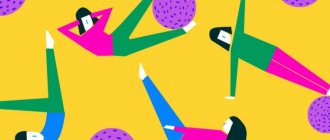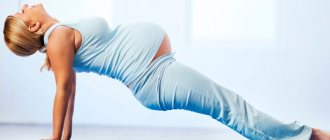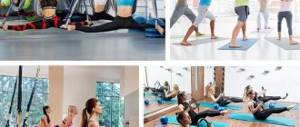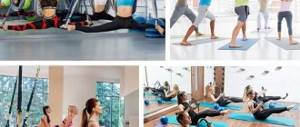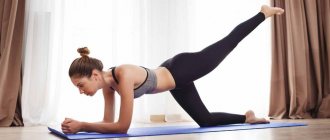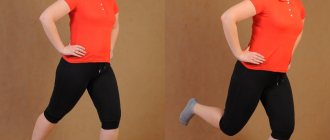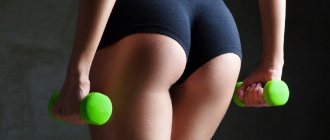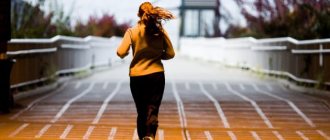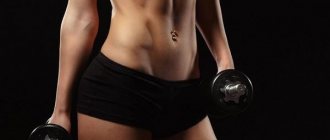Pilates makes the body beautiful and healthy, accelerates metabolism and has no contraindications. Get sets of effective exercises for all muscle groups and make your body perfect without leaving home!
Author: Kristina Lobanovskaya, doctor, practicing nutritionist Article updated: 11/10/2020
Ask a Question
Pilates is a system of physical training that has existed for about 100 years. At a young age, it was developed by the German Joseph Hubert Pilates. At the same time, he initially used exercises to treat his own body: until the age of 14, the future founder of the sports direction suffered from many diseases, which included rheumatism and asthma. Later, when Joseph moved to live in the USA, his technique became widespread. Over time, Pilates began to be used for improving the body and modeling the figure by various famous personalities, cultural figures, music, and cinema. Then he began his journey around the world and finally came to us.
The effectiveness of Pilates for weight loss
The very idea of Pilates is based on performing all the exercises slowly, during which you feel every muscle in your body. The smoothness of movements virtually eliminates the possibility of injury during training, and also makes the complexes suitable for a wide variety of people. But Pilates is especially popular:
- for rehabilitation after injuries;
- in pregnant women;
- adherents of a healthy lifestyle.
Is Pilates effective for losing weight? Definitely yes! Thoughtful, measured strength training allows you to gradually and safely get rid of extra pounds, and the results obtained during exercise last for a long time. Why does this happen?
During one Pilates workout, a person burns about 250-350 calories. If you compare this indicator with the effect of running or cycling, it is not impressive. However, this opinion is wrong: Pilates has completely different principles of influence on the body. During classes, the main thing is not the amount of energy spent, but the development of the muscle frame without increasing its mass. Thanks to this, metabolism “accelerates” and the amount of energy burned by the body at rest increases. And in the long term, this provides much more effective weight loss than rapid weight loss or replacing fat tissue with muscle tissue. To achieve effective weight loss, you need to adhere to the basic rules and principles of training:
- breathing during exercise should be deep and measured;
- performing each element in Pilates requires deep concentration on what you are doing. This allows you to better feel your own body and learn to control it;
- training must be consistent and regular so that the achieved result is constantly consolidated;
- During exercise, the muscular frame: all the muscles of the abs and back should be constantly kept in tension.
Does Pilates help heal the body? Yes. In this section of aerobic gymnastics, all exercises have a comprehensive effect on the body. That is, the work is carried out not with individual muscle groups, but with the majority of muscle mass at once. Thanks to this, the cardiovascular and respiratory systems receive a “payload”, and blood flow improves.
Training helps fight not only muscle and joint pain and poor posture, but also headaches, vascular and lung diseases, nervous tension and stress.
And this is not the only advantage of Pilates!
- Training is available to everyone! Attention! There are no contraindications for them, and you can perform the exercises both in the gym and at home, following a ready-made program.
- Due to the smooth execution of the techniques, classes do not cause unpleasant consequences: shortness of breath, physical and mental exhaustion, injuries, damage.
- By doing Pilates, you can make your body the way you want it to be: tighten it up, develop plasticity.
Training will lead you to harmony with your own body, teach you to perceive it adequately, without sharp emotional reactions.
Exercises for weight loss
Pilates gymnastics is considered difficult in its implementation, since during training it is necessary to fully control all muscles. That is why beginners are recommended to get acquainted with the technique in the gym, under the supervision of a trainer. But even in this case, you need to know the basic rules for doing the exercises:
- You need to breathe deeply, spreading your ribs as far as possible, contracting your muscles as you exhale.
- Access to key exercise points should be comfortable and natural. If you feel uncomfortable during Pilates, you are most likely doing something wrong.
- During exercise, you should not raise your shoulders, throw back or lower your head. Incorrect body position interferes with normal breathing and prevents all muscle groups of the body from working fully.
- Keep your abs tense all the time.
- Try to stretch your spine. This will not only benefit your back, but will also make your body more flexible.
Armed with knowledge about Pilates, you can begin to select a training system. Any set of exercises consists of 3 main blocks:
- for the belt and spinal region;
- on your feet;
- on the waist and abs.
At the same time, different types of programs can be designed to obtain different results:
- recovery from injuries;
- rehabilitation in the postoperative period;
- preparation for childbirth;
- preparation for various competitions;
- weight loss.
On the press
Abdominal exercises in Pilates are difficult to classify into a separate group. The oblique and rectus abdominis muscles are involved in all techniques. They are constantly under tension. However, there are some techniques that allow you to most effectively get rid of extra centimeters on the sides and waist.
- Take a neutral position. Raise your right leg vertically up and make 10 circles in the air. At the same time, stretch it upward, but make sure that the other thigh and lower back are pressed to the floor. Switch legs and repeat the exercise.
- Lie flat on the mat with your arms extended along your body. Lift your back and legs off the floor, leaving only your buttocks as support, keep your arms in the same position on weight. Exhale. As you inhale, stretch your arms and body forward, and bend your legs at the knees, trying to reach your chest with them.
- Sit with your knees pulled tightly to your chest and your arms wrapped around them. As you exhale, gently lean back and touch the floor with your shoulder blades. Then go back.
- Lie on your back, straighten your legs and keep them hip-width apart. Keep your arms suspended, lower your head to your chest. Raise your body with your abdominal muscles as you exhale and return to the starting position.
- From a neutral position, lift your legs up with your knees bent. In this case, the hip joint should have an angle of 90 degrees. Grab your shins with your hands and lift your upper body up. As you inhale, pull one leg towards your head, and at the end point make 2 springy movements. At this time, keep your other leg suspended and stretch it forward. As you exhale, quickly switch legs and repeat the exercise on the other leg.
For legs
Pilates for legs also includes many exercises aimed both at their general modeling and at tightening individual areas: thighs, inner and outer surfaces of the legs, and shins. You can perform the exercises in any order that is convenient for you, but it is best to warm up the largest muscles first, and then move on to narrow-profile training.
- From a neutral position, lift one leg straight up and point your toes toward the ceiling. Use it to draw circles through the inside, and then change legs.
- From a lying position, lean on your hands and lift your body up, forming a 45-degree angle between it and your legs. Raise both legs up as far as you can and, without spreading them, describe 10 circles, first in one direction and then in the other direction.
- Bend your knees and lift them so that 90-degree angles are formed at the hip and knee joints. Perform circles with your shins in one direction and then in the other direction.
- Roll over onto your stomach. Keep your legs straight and arms extended forward. Tighten your abs. While exhaling, lift your right arm and left leg off the floor and make 5 synchronized swaying movements with them, and then lower them as you exhale. Repeat the technique in a mirror manner.
- Return to a neutral position. Lift your pelvis up and support your lower back with your hands. Do not tense your upper body while doing this. Bend one leg in weight so that the knee is pointing up. Move your legs as if you were pedaling a bicycle.
- Without changing your position, spread your legs to the sides. As you exhale, make 3 fairly intense movements with your legs so that they cross and the top leg changes each time. This movement is often called "scissoring".
At home
Doing Pilates, according to the program for beginners, is not difficult at home. However, it is important that the complex is light, suitable for developing key deep muscles.
- Take the starting position. Do not forget that the lumbar region should lie completely on the floor. Tighten your stomach and lift your tailbone up a little. Breathe in. As you exhale, gradually lift your body up, lifting your back vertebra by vertebra, until you reach a position in which your entire body, from your knees to your chest, forms a straight line. At this time, the shoulder girdle should remain motionless, the neck should be relaxed. Inhale again, and as you exhale, slowly return back. Repeat the exercise 10 times.
- Without changing your position, lift one leg up without straightening it. As you exhale, change the position of your legs in weight. At the same time, make sure that your lower back remains motionless. The movements should be provided by the abdominal muscles. Do 20 shifts.
- Turn around to face the floor: your arms are bent at the elbows, your palms are at neck level, parallel to each other. Pull your legs back and place them straight. Breathe in. As you exhale, use your arm muscles to lift your upper body up, but not too much. The lower part of the chest should not come off the floor. The goal of the exercise is not to arch your back. Try to lengthen your spine without straining your waist. The legs remain motionless. Do 10 reps.
- Get on all fours so that your knees and hip joint are in line. The same applies to the position of the shoulders and palms. Tighten your stomach. Inhale, and as you exhale, lift the opposite arm and leg up, stretching it out. Pause for a second at the extreme point when your arm and leg are parallel to the floor, and slowly return them back. Repeat the movement for the other pair of limbs. At the same time, try to make movements as slowly as possible. Do 20 repetitions.
Method “Pilates for 10 minutes”
In the latter case, the 10-minute Pilates system is especially popular, which allows you to get rid of excess calories by devoting very little time to training every day. It is based on warming up and preparing the muscles of the back, abs and hips, as well as breathing exercises.
- Lie in a neutral position. To do this, lie on your back, pressing your lower back firmly to the floor. At this time, the abdominal muscles should be relaxed, the arms should be extended parallel to the body. The knees should be bent and placed in line with the hips and feet, which should be in a stable position. Move your hands to your abs. Inhale deeply while simultaneously inflating your belly. After this, exhale, drawing in your stomach as much as possible, helping yourself with your hands.
- Place one hand on the back of your head. As you exhale, lift your body as if you were doing abs, and then try to press your body towards your knees. Inhaling, gently and slowly lie back down.
- Without straightening your legs, lift them off the floor so that a 90-degree angle is formed at the hip joint. Hold yourself by your hips with your hands. While exhaling, do 3-6 dynamic chest and shoulder lifts with low amplitude. In this case, the hands should be in the air, along the body, with the inside facing up. Return to the starting position and inhale.
- Without changing your body position, place your palms on your knees and inhale. After this, as you exhale, lift your shins up and draw a large circle in the air.
- Straighten your legs, but continue to keep them suspended. Alternately bending your knees, try to pull them towards yourself, using your abdominal muscles and helping with your hands. Do this exercise at a faster pace than the previous techniques.
- Without changing the position of your legs, place your hands behind your head. Exhaling, turn your body to the left and try to reach your right elbow with your left knee. Return to the starting position, take a deep breath, and then repeat the move in a mirror manner.
- Straighten your legs and lower them to the floor. Inhale, and as you exhale, move your straight arms behind your head and smoothly lift your body with them, and then bend towards your feet.
- Position your legs vertically so that they point straight up. Using your abdominal muscles, without straining your neck, lift your shoulders and chest, and raise your arms and keep them straight in the air along your body. Start moving your hands in a vertical direction with a small amount of flow, as if there are dense springs under your palms, and you are pressing on them at a fairly fast pace. In this case, you need to work the shoulder muscles. As you exhale, do 5 “swings” with your palms down, and as you inhale, turn them the other way around.
- Do not change the position of your legs. As you exhale, clasp your right thigh with both hands. Pull your straight leg towards you, lifting your body towards it and simultaneously lowering the other down. Then return to the starting position, inhale and repeat everything in the mirror.
- From the same starting position, perform a similar exercise, only pull your leg towards you, bending it at the knee.
- Take the neutral position from which you began your Pilates workout. As you inhale, tighten your muscle frame and lift your pelvis up so that your body forms a straight plank from your waist to your knees. As you exhale, gently lower yourself down.
- Cool down especially slowly. Stretch your legs straight and place your arms along your body. As you exhale, bend your right knee and twist your torso to rest on the floor to your left. At the same time, stretch your right hand in the right direction, helping yourself. Go back and repeat for the left leg.
Perform all exercises 10 times, except for the last one: it is enough to do it once, but you should feel the tension.
When performing training, follow some more rules
- You need to do Pilates on an empty stomach, so don’t eat anything an hour before your workout. It is advisable to fast for an hour after performing exercises.
- Choose clothes that have good stretch and are light and comfortable. It is better to give preference to figure-fitting leggings and a T-shirt. Feet should be bare during training. As a last resort, you can wear thick socks.
- Since most Pilates techniques are performed on the floor, be sure to provide a mat or thick towel. It is important that it does not slip during your movements.
- Perform all exercises, smoothly moving from one to another. If at any point you feel pain or discomfort, stop exercising.
Perhaps now you have a question: Pilates or callanetics - what was described in this article? It is logical, since these directions are similar in many ways, but in key points they are very different.
Both areas of aerobic training are based on smooth and thoughtful execution of techniques. However, callanetics was developed by a ballerina with extensive experience for herself, and therefore it is intended for people with good physical fitness. Pilates is specifically aimed at physically weak people who need to develop and strengthen their muscles.
In addition, it should be noted that callanetics is a direction based on working with all muscle groups at once. However, during exercise, only large muscle sectors work, but the “lazy” areas of the body usually remain unaffected. So if you are an experienced athlete who needs to rehabilitate the body after heavy loads or keep in shape in the off-season, this is for you. For everyone else, it’s better to pay attention to Pilates for now.
Pilates for legs and buttocks - exercise technique
Before considering the most effective exercises, it is worth paying attention to the features of their implementation:
- while performing movements, it is necessary to keep your back level;
- if the plank exercise is performed, then the body should be stretched out;
- movements on the ground are performed so that the lower back does not come off of it;
- try not to help yourself with your neck if this is not provided for by the rules for performing a specific movement;
- special attention should be paid not to the number of repetitions, but to the quality of the exercise;
- each movement does not need to be performed more than 15-20 times;
- If ailments of the musculoskeletal system have worsened, then you should stop training for a while.
